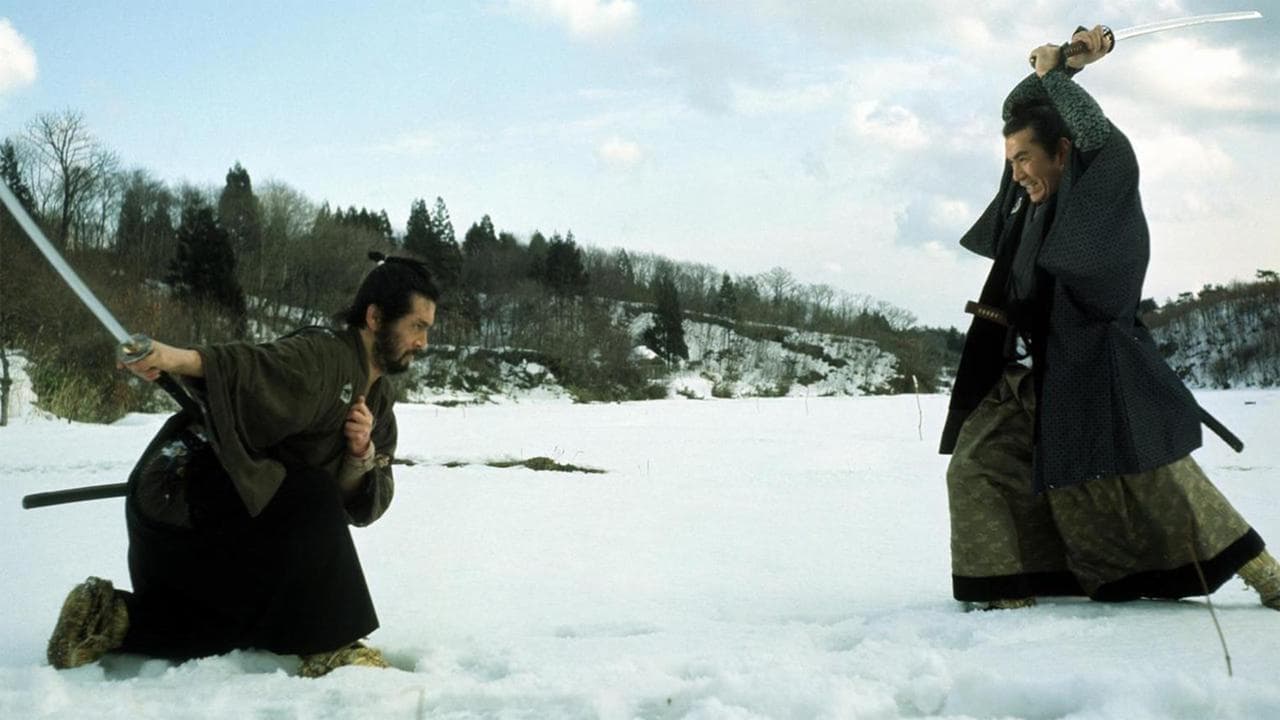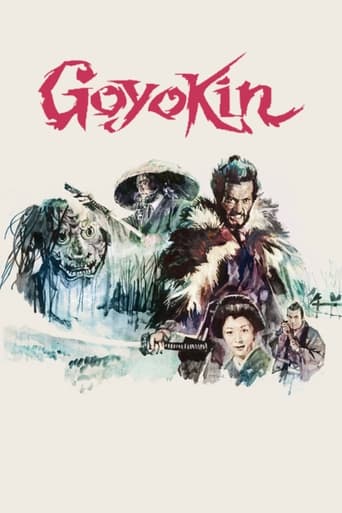

Goyokin is a hauntingly beautiful story of a Magobei Wakazaka a samurai turned to a drunk guilt ridden ronin after taking part in the slaughter of some innocent people because he was following orders from his brother in law in a plot to steal some official gold (Goyokin). When his brother in law decides to steal more gold and kill more people some assassins come for Magobei to silence him forever. This causes Magobei to throw down the bottle of sake and take up the sword once again. He decides to journey back to stop the slaughter and seek redemption.Gosha tells the classic story of a samurai and his giri-ninjo conflict, that is his struggle against following orders which is the way of the samurai, or doing what he believes is right. He uses his trademark crows as symbolic supernatural supervisors of karma and in such a way it eerily beautiful and unforgettable.
... View MoreThis is a special beast of a samurai film because of several things. For starters it is often compared unfavorably to "Sword of Doom" (completely nihilist B&W psycho samurai also starring Tatsuya Nakadai as a clone of his Yojimbo character). Quite frankly, Goyokin is far superior in nuance, photography and character depth. It holds that edge and an inherent darkness that is exquisitely explored visually over most samurai films in existence: more poetic than Zatôyichi (2003, Kitano), better filmed and written than Sword of Doom (1966, Okamoto), less remote than Ran (1985, Kurosawa) and darker and deeper than Yojimbo (1961, also Kurosawa); the only samurai to best this is Seven Samurai. Tatsuya Nakadai comes across as three-dimensional, which is a departure from most chambara film heroes, and tormented but eminently likable. Every character is given sufficient growth and motive. Masaru Sato gives us one of his finest scores ever (the other being that of Yojimbo). The photography defeats any samurai film that could possibly cross your mind (yes, even Ran and by a narrow margin Seven samurai's stark B&W beauty)! The fights have a sincere brutality and make the most of their environment... There is little else to add... well no maybe there is. Don't go in expecting pop-corn entertainment but rather something deeper more complex.I've heard that Inagaki's Samurai trilogy was Japan's "Gone With the Wind", Red Beard it's "Titanic" and Seven Samurai its ultimate western... if so, "Goyokin" is its "Lawrence of Arabia"!
... View MoreI saw "Goyokin" in 1969 at a small theater in Yokohama, Japan. It was in Japanese, of course, but the evolution of the story was understood. The film was so well done, and beyond what I was used to as an American watching Japanese movies in Japan. The acting was superb and the tension was palpable. The story was unique and its presentation was gorgeous. It's not hyperbole to say I was awestruck. With the advent of VHS I began searching for this movie as a video. After years of searching, I bought a barely watchable re-re-re-reprint with multiple subtitles. I was happy to HEAR the movie again! Tom ("Billy Jack") Loughlin made the putrid, displaced "The Master Gunfighter" but it was ludicrous as a Western. I will never understand why this classic has not been produced as a Video! Obviously, many people know about it, and it appears on wish lists throughout the world. It deserves the full DVD treatment and, PLEASE, while the great Tatsuya Nakadai is still alive to provide commentary on it.
... View MoreFrom the truly creepy opening to the climax, this movie holds your attention, both with its cinematography and (more preciously) a gripping and coherent storyline.Excellent filming techniques in this film hold your attention, when the suspense (yes! actual suspense!) doesn't. The acting (by Nakadai Tatsuya, one of Japan's greatest actors -- far better than Mifune Toshiro, IMHO) is top notch. Finally, the violence (though there's plenty) never degenerates into splatter. The violence appears much more disturbing (intentionally so) and much less titillating than in many "chambara" movies. Also noteworthy, this movie plays on the "loyalty vs. morality" theme that Gosha seems so fond of hammering. In this particular movie, however, he really pulls it off with some intelligence. Though I'm a big fan of Gosha, I have to admit that not everything he touches turns to "gold" (Get it? You will...).Even so, if you're going to sample from the "chambara" genre, this is among the best (my other nominee would be "Hitokiri/Tenchu" (1969). Frankly, I think it's among the best Japanese films, period.
... View More